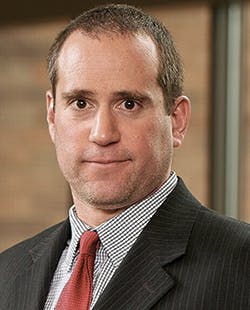New for 2022: Artificial intelligence and machine learning for preventive maintenance optimization
Aaron Merkin is the CTO of Fluke Reliability, and has been with the business for a little more than a year. He is responsible for all hardware and software engineering and product development, with about two decades experience developing enterprise software and solutions across a variety of industries, specifically serving asset-intensive industries developing MRO solutions. Aaron sat down last December with Plant Services Editor in Chief Thomas Wilk to take a look ahead at technology trends for 2022.
PS: We saw a strong interest in remote condition monitoring emerge in the past 18 months. What do you see driving remote condition monitoring in 2022? How do you see it evolving?
AM: I think we’ll see that because of the inability of people to be on-site. I think there’s sort of a secular trend, which is the graying of the workforce and a lot of people heading toward retirement. That was accelerated quite a bit with COVID in terms of people really rethinking just, in general, their life choices, and how much they want to continue working, or if they want to ease into retirement. As well as with health concerns, people not being comfortable going on-premise, and going into facilities and performing maintenance activities. I think we’ve seen a sort of an acceleration and an interest at looking into alternatives rather than using their own staff to do maintenance inspections on-premise.
And as we’ve sort of been through the peaks and troughs of COVID, particularly when we were going through the large area of uncertainty, there was a lot of interest in RCM, in remote condition monitoring services, but not necessarily an ability to actually take advantage of them because of the travel issues and access issues. Now the vaccination rate’s coming up, and people are getting more comfortable with reopening their facilities, I think is when we’re going to see in 2022 a significant adoption of those services. The end of 2021 was really learning what it’s all about, and what are alternatives for how we can perform these maintenance activities and monitoring.
In 2022, we’ll see now people taking advantage of that. I think that there’s a broader understanding of the availability of these services in both the RCM aspects as well as a bit more of the transition to continuous monitoring versus route-based. I think there’s certainly room for more education and more awareness to be raised about the breadth of the assets that can be covered, as well as the affordability of the services themselves.
PS: Yes, that’s an issue too, costs can be variable for these kinds of situations. A lot of times when we survey our readers, what we find out is that they’re not really sure how to quantify the benefits of solutions like this. And so, costs can be an obstacle, especially if they’re not sure what the return will be.
AM: I think what we have is, we have an understanding that planned downtime is better than unplanned downtime. And it’s the ability to perform preventative maintenance, particularly less maintenance activity, less engineering resource effort, as well as potentially with lower-cost parts, that is inherently better for a business than having an unplanned outage and having to perform major repairs to the system.
There’s a concurrent trend, which is supply chain limitations, and one of the areas that we’re seeing is that, if we’re able to provide you through RCM (or a customer or a plant supervisor) to have an earlier lead time of a fault, then they’re much more likely to be able to order the parts that they need and have them in-house and be ready to be able to schedule the repair before that fault actually occurs and takes down the plant, and they have a significant line down while they’re trying to deal with supply chain issues and get repair parts in.
This article is part of our monthly Automation Zone column. Read more from our monthly Automation Zone series.
PS: Can you talk about how an EAM system can help bring reliability back to the supply chain, the impact that it can make when it’s all being done right?
AM: I think the key thing on the reliability side is that in order to have an effective maintenance program, you need to understand what preventive maintenance procedures need to be run, and you need to know when you’re going to run them, ideally when there’s a lot of work being done, particularly in the RCM side to transition from meter-based to time-based maintenance and to condition-based maintenance. But still, if you have all that condition monitoring up-front, or you have your meters coming into a system triggering the maintenance program, if you’re not actually effectively tracking and performing that maintenance, then knowing that you need to do it is only half of the solution.
A software tool like eMaint is really there to help you perform, track, and execute well the PMs that need to be done. We also see the application of AI and ML in that space as well. Again, the advantage of a SaaS platform such as eMaint is with large datasets we have PMs being done for a wide variety of assets. We’re able to start looking at comparing best practices across multiple customers, as well as looking for which PM routines are constructive for a given asset class. You’re actually seeing an improvement in reliability asset in which a PM routine is actually potentially disruptive. I don’t know about you, but when I perform my maintenance routine at home, I feel like there’s always that one screw left over that I forgot where it goes back to.
One of the things that we’re looking at exactly on the PM side, is a similar thing. The OEM will tell you, “here are the routines you should perform” but it’s quite possible that they’re not necessary because they’re not really contributing to the health of the asset, or potentially that, as I said, you’re cracking the system open into performing some maintenance on it is actually ultimately leading to a long-term degradation of its reliability. So we see that the structure of the PMs and eMaint, and the application of AI and ML as being the basics of PM being a firm foundation for reliability, and it being a starting point to actually do PM optimization over the long term as well.
New for 2022: Artificial intelligence and machine learning for preventive maintenance optimization
How to manage cybersecurity risks at your manufacturing plant
Cover all your lockout/tagout bases: Implementing the 5 OSHA-mandated steps
PS: That’s really fascinating. A lot of the AI and ML use cases that we’ve encountered at least have been to predict the imminent failure, to identify the anomaly. What you’re talking about is an intriguing new case where you can identify the harmful work – not just work that’s no longer useful, but work that may actually be introducing the faults.
AM: We think about asset performance management broadly, the evolution of reliability, again, away from sort of the time-based, and scheduled PMs into condition-based and prescriptive maintenance driven by AI and analytics. What we’ve seen is that the kernel of it, the nugget of it is really what we might consider asset health, and that is this condition-based predictive maintenance, using condition monitoring to do predictions of the asset health. But the evolution of that is, as I said, ultimately PM optimization is deciding which maintenance routines really are the ones which make sense to be done because it’s improving the health versus, as I said, the ones which could be set aside.
There’s also some room there as well, if you have a large enough fleet of assets to start doing some comparisons, both in terms of not just, “is this PM routine effective or not?” but with detailed work instructions in the capturing of the PM in a work order and a tool like eMaint, you can start doing analysis to determine if two different entities or two different maintenance crews are performing the same PM, looking at the variation between the actual execution of the PMs, and seeing which of the PM routines is more effective at improving the asset health as well.
Listen to the entire interview
This story originally appeared in the March 2022 issue of Plant Services. Subscribe to Plant Services here.

